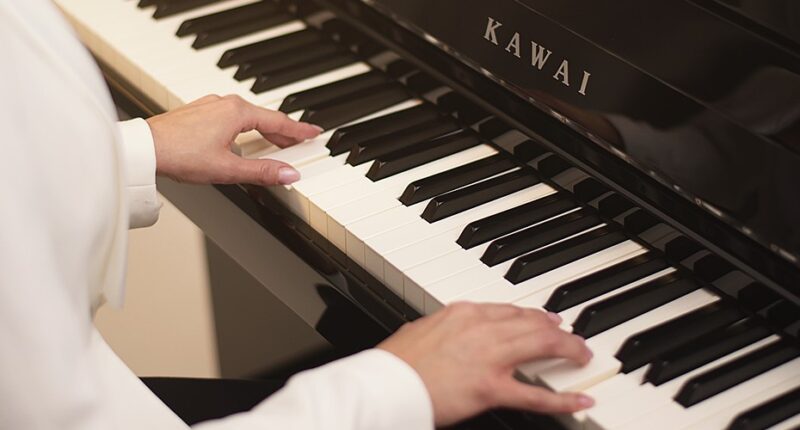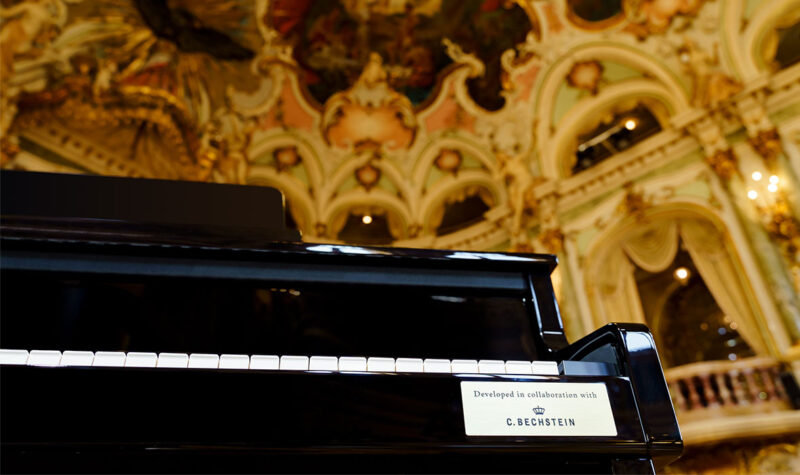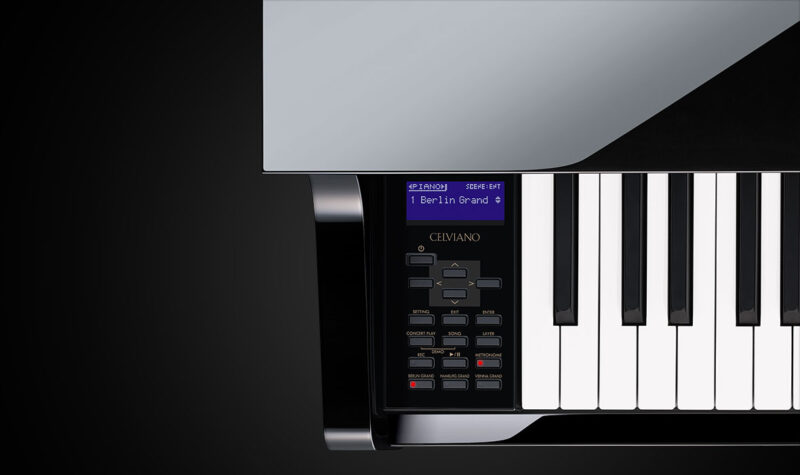The high-end digital piano market is more popular than ever. The level of musicality these pianos are now capable of combined with the convenience and inherent advantages of a digital instrument have made Hybrid digital pianos are a legit option for folks who would have previously only considered an acoustic piano, whether you’re a beginner or experienced pianist.
Today, we’ll be comparing two of the most popular hybrid digital pianos currently available, the Kawai CA99 vs Casio GP 510. The GP510 is the flagship model of the Celviano line and the big brother to the Casio GP 310, while the CA99 is the top model of the CA series and big brother to the CA79.
We’ll be discussing the differences in action, tone and features, and giving our thoughts on which one might be better for you, based on your needs and musical preferences.
Both of these pianos are probably known for their key actions most of all, so we’re going to start there and spend more time discussing action than we normally do.
Kawai CA99 vs Casio GP 510 – Hybrid Digital Piano Action

Casio’s 88 Wooden Key Natural Grand Hammer Action Keyboard Designed by C. Bechstein
If there’s a centerpiece to the Celviano Grand Hybrid GP-510, it is the action. The big thing that catches people’s eye is the fact that this action was designed in collaboration with German piano maker C. Bechstein.
C. Bechstein is known for building some of the most accurate and finely-regulated actions available anywhere in the world. They’re fanatical with their tolerance and attention to detail.
And what’s interesting here is that they’ve gone for an action that greatly resembles a true grand piano action with full-length wooden keys. It’s not on the same level as a Kawai NOVUS 10 or Yamaha Avant Grand which both feature genuine acoustic grand piano actions, but both of these instruments cost substantially more than the GP-510 or CA99.
Improvements Over the Previous Generation Action
One of the things that we thought needed some tweaking with the previous version of this action found in the GP-500 was some additional regulation at the factory – the touch felt a little bit loose which was a shame since the concept was clearly so great.
We’re happy to report that this new version really does feel like an acoustic piano. Casio has done a really great job of creating the right weight and getting a great repetition speed. The key bed has nice cushioning and everything in general feels quite authentic.
Real Hammers
A very cool feature of this action is the fact that it actually uses real hammers, and the cabinet is designed in such a way that you can actually prop open the top lid the see the hammers in action.
Textured Keytops
The white keys feature a polished plastic that is different than the exaggerated key texture most of their other digital piano actions have. This one actually provides a little bit more grip than we prefer, though that should get better with time as the natural oils from the player’s skin get worked in.
Casio GP 510 Action Wrap-Up
This Casio Grand Hybrid is offering a super authentic action overall with very believable dynamic weight. We think that for the price point, this has got to be one of the top two or three actions available, and some folks will definitely find the touch response superior to the CA99.
Kawai’s Grand Feel III Action

The Kawai CA99 digital piano is an instrument that we have reviewed in quite a few contexts on its own in comparison to a few others on our YouTube channel, so we’ve talked a lot about the Kawai Grand Feel III action (GFIII), which is also featured in the Kawai CA79.
This is the first time we’ve done a head-to-head with the CA99 vs the GP-510 and of course, the action is the biggest point of comparison. The GP-510’s action boasts a unique touch that for certain types of playing actually feels more natural than the GFIII, which may sound surprising given how much we love the GFIII here at Merriam Music and the fact that many people consider it the top action the class.
Extended Length Key-Sticks
The Grand Feel III action actually uses the same key stick length as what you are going to get on an upright piano as opposed to a grand piano. Even though it’s called Grand Feel III, the dynamic and the static resistance actually feels closer to what you might find on a Kawai K200 or K300 upright versus what you’ll get on a Kawai grand.
Now, it does still deliver a fantastic playing experience, and the longer keysticks offer the player a ton of control.
Triple Sensor Key Detection, Counterweights & Let Off Simulation
A couple of features worth highlighting on the GFIII are the triple sensor, counterweights and let-off. Triple sensor key detection means the GFIII is capable of very accurate MIDI output and a wide range of dynamics. This is as good as it gets before getting into the advanced optical sensor technology found in the NOVUS series.
Counterweights ensure that the weighting of the action is as close to an acoustic piano as possible, and let-off simulates the sensation the player gets when playing a grand piano.
Ivory Touch & Ebony Touch Key Surfaces
The GFIII has very nicely textured keytops out of the box on both the black and white keys, which we definitely prefer to the GP510’s action as they provide just the right amount of grip and glide.
Kawai CA99 Action Wrap-Up
Kawai’s Concert Artist series digital pianos always feature great action, and the GFIII is no different.
We think both actions are going to be satisfying to just about everyone, but if you have a chance to play both the GP510 and CA99, odds are you will prefer one action over the other based on your playing style.
Kawai CA99 vs Casio GP 510 – Hybrid Digital Piano Sound
Shigeru Kawai SK-EX Resonance Modeling Engine with Multi-Channel Sampling

There are many aspects of the tone on the CA99 which are noteworthy and worth exploring. When you fire the CA99 up, it defaulted to ‘Piano Mode’ which features Kawai’s latest SK-EX Rendering engine which complexes with multi-channel 88-key stereo sampling with advanced modeling technology.
This acoustic rendering approach is very similar to what Roland has pioneered in the digital piano space with their SuperNATURAL and V-Piano engines.
The piano tone here is simply stunning – a truly impressive capture of Kawai’s flagship SK-EX concert grand piano.
Unlimited Polyphony
When you’re in Piano Mode, you get unlimited polyphony to work with. That means we could play hundreds and hundreds of notes, and the instrument is going to continue to be able to sustain and render, and create those tones without ever running out of memory. And it’s one of the first times Kawai has released an instrument that has that type of technology.
Harmonic Imaging XL Engine
When out of Piano Mode, Sound Mode engages, and this utilizes Kawai’s Harmonic Imaging XL (HIXL) engine. There are additional acoustic piano patches available with this engine, along with all of the non-piano tones which can be navigated via the LCD touchscreen. It’s very interesting to toggle between both modes to hear the very clear differences.
There seems to be much more detail around the edges of the notes and in the space between the notes with the Rendering engine engaged, though the HIXL is no slouch either.
Kawai’s Virtual Technician Feature
With Kawai’s Virtual Technician feature engaged, the user gets access to a whole bunch of editable sound-related parameters beyond things like reverb. string resonance settings and getting into the touch curve, voicing, damper resonance, damper noise, string resonance, undamped string resonance, cabinet resonance, key-off effect, fallback noise, hammer noise, hammer delay, top board, decay time, release time, minimum touch, and more.
Soundboard Speaker System
One of the highlights of the CA99 and the one feature that firmly establishes it as a Hybrid instrument is the real solid spruce soundboard. Even without the soundboard, the 6 speaker system is already impressive with top speakers plus speaker diffusers and 2 dome tweeters, but the magnet-driven soundboard with 360-degree diffuser panels takes things to a whole different level.
Audio company Onkyo has provided the amplifiers and signal processing, and there’s a whopping 135 watts of output power available at your disposal here. With that kind of power being driven through a real soundboard, you can be assured that the CA99 sounds incredible.
There’s also a separate headphone amplifier and their Spatial Headphone Sound feature when playing with headphones which is a really nice bonus.
Casio’s AiR Grand Sound Source

Casio is using the most advanced version of their AiR Sound Source in the GP-510BP, which stands for Acoustic & Intelligent Resonator. This engine also features the most sophisticated version of their Multi-Dimensional Morphing technology which serves to facilitate the smoothest possible transitions across various dynamic levels.
Three core acoustic piano samples make up this engine – the Berlin Grand which is based on a C. Bechstein D282 concert grand, the Hamburg Grand which is based on a Hamburg Steinway Model D concert grand and lastly the Vienna Grand which is based on a Bosendorfer Imperial concert grand.
All three patches sound fantastic, with the Berlin offering the most clarity and color, the Hamburg delivering the power, and the Vienna coming across as more mellow with a very intimate tone.
256-Note Polyphony
The AiR Grand Sound Source features 256 notes of maximum polyphony across its 35 total presets. You might be disappointed seeing this in comparison to the CA99’s limitless polyphony on piano tones, but you really shouldn’t be.
256 notes of polyphony is more than enough for the vast majority of applications, especially for acoustic piano playing which the GP510 is made for.
Acoustic Simulator
Casio has their own version of user-editable sound-related parameters, which they refer to as the Acoustic Simulator.
The Acoustic Simulator features String resonance, Damper resonance, Open string resonance, Aliquot resonance, Damper noise, Pedal action noise, Key on action noise, Key off action noise, Hammer response and a Lid simulator.
Grand Acoustic System (Speakers)
Casio refers to their speaker set up here as the Grand Acoustic System. They’ve given the speaker system this fancier name to show their intent of specifically configuring the speakers in such a way that they recreate the 360-degree experience of playing a real acoustic grand piano.
The 6-speaker system is then strategically positioned to achieve this overall goal, which they pull off very well. There are 100 watts of total power here which is very good.
Sound Wrap-Up
Both pianos bring advanced, high-tech sound engines and speaker setups to the table. At the end of the day, individual preference is simply likely to go to whichever core grand piano patch you happen to prefer, though we could see those in the Worship community prefer the Kawai CA99 due to how fantastic the organ sounds come across thanks to the soundboard speaker system.
Additional Features & Connectivity

Functions
Both pianos offer a pretty standard array of functions with things like Layer, Split, Duet, Transpose, Metronome, Drum rhythms etc.
Both pianos also have a variety of built-in songs and music, as well as built-in audio recorders for saving on-board or via a USB flash drive and playback (SMF, WAV files.)
The CA99 has some built-in lesson books from Alfred, as well as repertoire from Chopin and classic works from Bach and others.
The GP510 offers Casio’s much-loved Concert Play feature and Music Library which allows you to play along with a full orchestra.
Cabinet
The GP-510 is available in a gorgeous polished black cabinet with brass accents that is set to be a show stopper in any room, especially with the gold Bechstein logo. The lid height is also adjustable.
The CA99 is available in a variety of finishes – Premium Rosewood, Satin White, Satin Black as well as Ebony Polish for a premium. Kawai also incorporates their slow-fall fallboard as well.
Pedals
Both pianos feature built-in 3 pedal systems (damper, sostenuto and soft pedals) with half-pedal support. In the CA99’s case, it features Kawai’s Grand Feel Pedal System which is weighted exactly the same as a grand piano.
Connectivity
Both the CA99 and GP510 have a pretty similar set of connectivity jacks, with the exception of the fact that the CA99 has both Bluetooth MIDI and Bluetooth Audio, with APTX support.
This is actually a huge add-on, especially Bluetooth Audio, as it allows you to stream music directly from a smart device (iOS, Android) to the CA99, which then plays through the CA99’s fantastic soundboard speaker system.
The GP510 alternatively doesn’t offer any connectivity which is definitely somewhat of a disappointment from Casio considering even some of their inexpensive Privia models feature Bluetooth.
That said, the GP510 has a pretty full complement of connectivity otherwise as does the CA99 with L/MONO, R line inputs and outputs, USB Type A and B and MIDI. The Line Out is especially important if you’re considering either piano for some type of institutional setting.
Closing Thoughts
It’s fair to say that we’ve got two highly compelling flagship pianos from two of the world’s leading digital piano manufacturers. Warranty coverage is great on both, as is the overall aesthetic effect each piano possesses.
They’re both designed to offer a similar experience, and both pianos pull this off very well.
The Kawai CA99 may have some extras like the spruce soundboard and Bluetooth connectivity that will be deal breakers for some folks, but at the end of the day as we often say around here, you should really try both and see which combination of touch and tone you prefer, all things being equal otherwise.
Thanks for reading!

